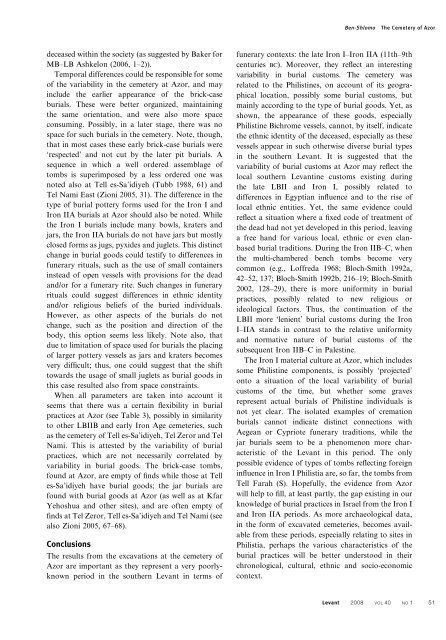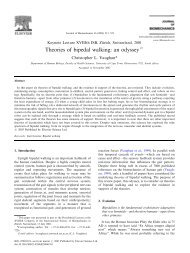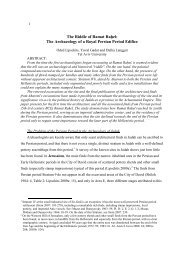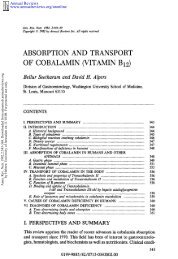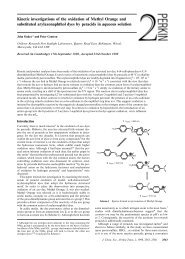The Cemetery of Azor and Early Iron Age Burial Practices
The Cemetery of Azor and Early Iron Age Burial Practices
The Cemetery of Azor and Early Iron Age Burial Practices
Create successful ePaper yourself
Turn your PDF publications into a flip-book with our unique Google optimized e-Paper software.
Ben-Shlomo<strong>The</strong> <strong>Cemetery</strong> <strong>of</strong> <strong>Azor</strong>deceased within the society (as suggested by Baker forMB–LB Ashkelon (2006, 1–2)).Temporal differences could be responsible for some<strong>of</strong> the variability in the cemetery at <strong>Azor</strong>, <strong>and</strong> mayinclude the earlier appearance <strong>of</strong> the brick-caseburials. <strong>The</strong>se were better organized, maintainingthe same orientation, <strong>and</strong> were also more spaceconsuming. Possibly, in a later stage, there was nospace for such burials in the cemetery. Note, though,that in most cases these early brick-case burials were‘respected’ <strong>and</strong> not cut by the later pit burials. Asequence in which a well ordered assemblage <strong>of</strong>tombs is superimposed by a less ordered one wasnoted also at Tell es-Sa’idiyeh (Tubb 1988, 61) <strong>and</strong>Tel Nami East (Zioni 2005, 31). <strong>The</strong> difference in thetype <strong>of</strong> burial pottery forms used for the <strong>Iron</strong> I <strong>and</strong><strong>Iron</strong> IIA burials at <strong>Azor</strong> should also be noted. Whilethe <strong>Iron</strong> I burials include many bowls, kraters <strong>and</strong>jars, the <strong>Iron</strong> IIA burials do not have jars but mostlyclosed forms as jugs, pyxides <strong>and</strong> juglets. This distinctchange in burial goods could testify to differences infunerary rituals, such as the use <strong>of</strong> small containersinstead <strong>of</strong> open vessels with provisions for the dead<strong>and</strong>/or for a funerary rite. Such changes in funeraryrituals could suggest differences in ethnic identity<strong>and</strong>/or religious beliefs <strong>of</strong> the buried individuals.However, as other aspects <strong>of</strong> the burials do notchange, such as the position <strong>and</strong> direction <strong>of</strong> thebody, this option seems less likely. Note also, thatdue to limitation <strong>of</strong> space used for burials the placing<strong>of</strong> larger pottery vessels as jars <strong>and</strong> kraters becomesvery difficult; thus, one could suggest that the shifttowards the usage <strong>of</strong> small juglets as burial goods inthis case resulted also from space constraints.When all parameters are taken into account itseems that there was a certain flexibility in burialpractices at <strong>Azor</strong> (see Table 3), possibly in similarityto other LBIIB <strong>and</strong> early <strong>Iron</strong> <strong>Age</strong> cemeteries, suchas the cemetery <strong>of</strong> Tell es-Sa’idiyeh, Tel Zeror <strong>and</strong> TelNami. This is attested by the variability <strong>of</strong> burialpractices, which are not necessarily correlated byvariability in burial goods. <strong>The</strong> brick-case tombs,found at <strong>Azor</strong>, are empty <strong>of</strong> finds while those at Telles-Sa’idiyeh have burial goods; the jar burials arefound with burial goods at <strong>Azor</strong> (as well as at KfarYehoshua <strong>and</strong> other sites), <strong>and</strong> are <strong>of</strong>ten empty <strong>of</strong>finds at Tel Zeror, Tell es-Sa’idiyeh <strong>and</strong> Tel Nami (seealso Zioni 2005, 67–68).Conclusions<strong>The</strong> results from the excavations at the cemetery <strong>of</strong><strong>Azor</strong> are important as they represent a very poorlyknownperiod in the southern Levant in terms <strong>of</strong>funerary contexts: the late <strong>Iron</strong> I–<strong>Iron</strong> IIA (11th–9thcenturies BC). Moreover, they reflect an interestingvariability in burial customs. <strong>The</strong> cemetery wasrelated to the Philistines, on account <strong>of</strong> its geographicallocation, possibly some burial customs, butmainly according to the type <strong>of</strong> burial goods. Yet, asshown, the appearance <strong>of</strong> these goods, especiallyPhilistine Bichrome vessels, cannot, by itself, indicatethe ethnic identity <strong>of</strong> the deceased, especially as thesevessels appear in such otherwise diverse burial typesin the southern Levant. It is suggested that thevariability <strong>of</strong> burial customs at <strong>Azor</strong> may reflect thelocal southern Levantine customs existing duringthe late LBII <strong>and</strong> <strong>Iron</strong> I, possibly related todifferences in Egyptian influence <strong>and</strong> to the rise <strong>of</strong>local ethnic entities. Yet, the same evidence couldreflect a situation where a fixed code <strong>of</strong> treatment <strong>of</strong>the dead had not yet developed in this period, leavinga free h<strong>and</strong> for various local, ethnic or even clanbasedburial traditions. During the <strong>Iron</strong> IIB–C, whenthe multi-chambered bench tombs become verycommon (e.g., L<strong>of</strong>freda 1968; Bloch-Smith 1992a,42–52, 137; Bloch-Smith 1992b, 216–19; Bloch-Smith2002, 128–29), there is more uniformity in burialpractices, possibly related to new religious orideological factors. Thus, the continuation <strong>of</strong> theLBII more ‘lenient’ burial customs during the <strong>Iron</strong>I–IIA st<strong>and</strong>s in contrast to the relative uniformity<strong>and</strong> normative nature <strong>of</strong> burial customs <strong>of</strong> thesubsequent <strong>Iron</strong> IIB–C in Palestine.<strong>The</strong> <strong>Iron</strong> I material culture at <strong>Azor</strong>, which includessome Philistine components, is possibly ‘projected’onto a situation <strong>of</strong> the local variability <strong>of</strong> burialcustoms <strong>of</strong> the time, but whether some gravesrepresent actual burials <strong>of</strong> Philistine individuals isnot yet clear. <strong>The</strong> isolated examples <strong>of</strong> cremationburials cannot indicate distinct connections withAegean or Cypriote funerary traditions, while thejar burials seem to be a phenomenon more characteristic<strong>of</strong> the Levant in this period. <strong>The</strong> onlypossible evidence <strong>of</strong> types <strong>of</strong> tombs reflecting foreigninfluence in <strong>Iron</strong> I Philistia are, so far, the tombs fromTell Farah (S). Hopefully, the evidence from <strong>Azor</strong>will help to fill, at least partly, the gap existing in ourknowledge <strong>of</strong> burial practices in Israel from the <strong>Iron</strong> I<strong>and</strong> <strong>Iron</strong> IIA periods. As more archaeological data,in the form <strong>of</strong> excavated cemeteries, becomes availablefrom these periods, especially relating to sites inPhilistia, perhaps the various characteristics <strong>of</strong> theburial practices will be better understood in theirchronological, cultural, ethnic <strong>and</strong> socio-economiccontext.Levant 2008 VOL 40 NO 1 51


